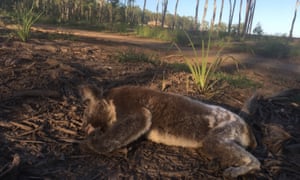Environmental Defenders Office to urge Palaszczuk government to amend proposed laws
The Queensland
Environmental Defenders Office says proposed new land-clearing laws in
the state leave significant loopholes that would allow broadscale
clearing to continue unchecked.
The group will on Thursday lodge a submission urging the Palaszczuk government to amend its proposed vegetation management laws.
In particular, the office is concerned the new legislation would allow landholders to continue to clear land based on vegetation maps that were “locked in” under the current regulations.
Queensland is responsible for more land clearing than the rest of the country combined. Rates of clearing surged when the state’s former premier Campbell Newman promised to scrap restrictions, which his Liberal National party government did in December 2003.
Those rates increased dramatically again, including heavy losses in Great Barrier Reef catchments, where the Palaszczuk government indicated it would attempt to restore protections during its first term.
Laws were introduced to parliament last year but lapsed when the election was called.
Annastacia Palaszczuk has promised the new plan will “end broadscale clearing in Queensland”.
But the Environmental Defenders Office, which says the laws are a “reasonable first step” has warned that clearing would continue apace without measures to force landowners to redraw maps that designated “category X” land – areas that were exempt from the Vegetation Management Act.
With new laws looming, agricultural groups have encouraged land owners to “lock in” their property maps designating “category X” land under the current framework.
The proposed new laws will not compel farmers and other landholders to redraw those maps to reflect more stringent environmental requirements for clearing.
The Environmental Defenders Office Queensland chief executive officer, Jo-Anne Bragg, said without measures to redraw property maps “these reforms will be ineffective”.
“A lot of Queensland is covered by [locked-in property maps]. We don’t know how many hundreds and thousands of hectares in Queensland is classified as category X,” Bragg said.
Bragg said voters expected the government would fully wind back the Newman era regulations, but the current proposal did not completely do that.
The laws tighten the definition of “thinning”, which can involve clearing of up to 75% of vegetation, and require than any thinning must “maintain ecological processes and prevent loss of diversity”.
But the Environmental Defenders Office says thinning has no scientific justification and should “no longer be an allowable activity by permit or code, particularly not for mature and high-value regrowth vegetation”.
Bragg said many pastoralists had expressed concern about land-clearing rates and agreed the regulations needed to change.
Committee hearings on the bill will be held on Friday, a day after submissions are due, with a report due back in parliament by 23 April.
The group will on Thursday lodge a submission urging the Palaszczuk government to amend its proposed vegetation management laws.
In particular, the office is concerned the new legislation would allow landholders to continue to clear land based on vegetation maps that were “locked in” under the current regulations.
Queensland is responsible for more land clearing than the rest of the country combined. Rates of clearing surged when the state’s former premier Campbell Newman promised to scrap restrictions, which his Liberal National party government did in December 2003.
Those rates increased dramatically again, including heavy losses in Great Barrier Reef catchments, where the Palaszczuk government indicated it would attempt to restore protections during its first term.
Laws were introduced to parliament last year but lapsed when the election was called.
Annastacia Palaszczuk has promised the new plan will “end broadscale clearing in Queensland”.
But the Environmental Defenders Office, which says the laws are a “reasonable first step” has warned that clearing would continue apace without measures to force landowners to redraw maps that designated “category X” land – areas that were exempt from the Vegetation Management Act.
With new laws looming, agricultural groups have encouraged land owners to “lock in” their property maps designating “category X” land under the current framework.
The proposed new laws will not compel farmers and other landholders to redraw those maps to reflect more stringent environmental requirements for clearing.
The Environmental Defenders Office Queensland chief executive officer, Jo-Anne Bragg, said without measures to redraw property maps “these reforms will be ineffective”.
“A lot of Queensland is covered by [locked-in property maps]. We don’t know how many hundreds and thousands of hectares in Queensland is classified as category X,” Bragg said.
Bragg said voters expected the government would fully wind back the Newman era regulations, but the current proposal did not completely do that.
The laws tighten the definition of “thinning”, which can involve clearing of up to 75% of vegetation, and require than any thinning must “maintain ecological processes and prevent loss of diversity”.
But the Environmental Defenders Office says thinning has no scientific justification and should “no longer be an allowable activity by permit or code, particularly not for mature and high-value regrowth vegetation”.
Bragg said many pastoralists had expressed concern about land-clearing rates and agreed the regulations needed to change.
Committee hearings on the bill will be held on Friday, a day after submissions are due, with a report due back in parliament by 23 April.

No comments:
Post a Comment